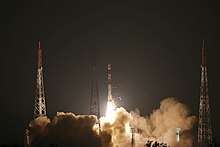PSLV-C44
The PSLV-C44 was the 46th mission of the Indian Polar Satellite Launch Vehicle (PSLV) program. It was the first flight of PSLV-DL, having 2 strap-on boosters and placed a primary payload Microsat-R and a secondary payload of Kalamsat V2 in sun-synchronous orbits.[1]
 Liftoff of the PSLV-DL launch vehicle during flight C44 | |
| PSLV-DL launch | |
|---|---|
| Launch | 24 January 2019, 18:07:00 UTC |
| Operator | ISRO |
| Pad | Sriharikota First |
| Payload |
|
| Outcome | Success |
| PSLV launches | |
PSLV-C44 launch
The PSLV-C44 was launched from the first launch pad of the Satish Dhawan Space Centre in Sriharikota at 11:37 P.M. IST on 24 January 2019, following a 28-hour countdown that began at 7:37 P.M. IST on 23 January 2019.[1][2]
Mission overview
- Mass:
- Payload weight: 741.2 kilograms (1,634 lb)
- Overall height: 44.4 metres (145.7 ft)
- Propellant:
- Stage 1: Composite Solid
- Stage 2: Earth Storable Liquid
- Stage 3: Composite Solid
- Stage 4: Earth Storable Liquid
- Propellant mass:
- Stage 1: 139,000 kilograms (306,000 lb)
- Stage 2: 41,000 kilograms (90,000 lb)
- Stage 3: 7,650 kilograms (16,870 lb)
- Stage 4: 1,600 kilograms (3,500 lb)
- Altitude: 450 kilometres (280 mi)
- Maximum velocity: 7,740 metres per second (25,394 ft/s) (recorded at time of Kalamsat separation)
- Inclination: 96.567°
- Azimuth: 140°[3]
The PSLV C-44 rocket had four stages; each one was self-contained, with its own propulsion system, thereby capable of functioning independently.[4] The first and third stages used composite solid propellants, while the third and fourth stage used earth-storable liquid propellants.[3] It had a lift-off mass of 230,400 kilograms (507,900 lb) and measured 44.4 metres (146 ft) in height.[4] It carried two satellites built by DRDO and Space Kidz India into orbit, weighing 740 kilograms (1,630 lb) and 1.2 kilograms (2.6 lb) respectively, bringing the total payload mass to 741.2 kilograms (1,634 lb).
The satellite Microsat-R was placed into a lower sun synchronous orbit of 274.12 kilometres (170.33 mi) altitude and 96.575° inclination, meanwhile, the second satellite was placed with an experimental 4th stage into an orbit of 450 kilometres (280 mi) altitude and 98.767°.[4] The satellite was launched free of cost and was placed into the orbit after 2 subsequent rocket burn past Microsat-R release.[5][6]
References
- "PSLV-C44 successfully launched Microsat-R and Kalamsat-V2 - ISRO". www.isro.gov.in. Retrieved 2019-01-25.
- "The countdown for the launch of PSLV-C44 mission". www.isro.gov.in. Retrieved 2019-01-23.
- "PSLV-C44 Launch Kit". ISRO. Retrieved 24 January 2019.
- "PSLV-C44 Brochure". ISRO. Retrieved 24 January 2019.
- ISRO. "PSLV C44 Mission". Archived from the original on 17 January 2019. Retrieved 13 January 2019.
- Economics Time. "World's lightest satellite 'Kalamsat-V2' lifts-off successfully from Sriharikota". Retrieved 25 January 2019.